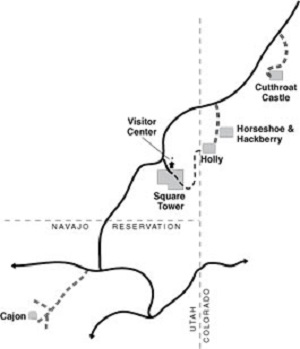
Courtesy of National Park Service
In a relatively remote area along the Colorado and Utah border, narrow ravines, steep canyon walls, and flat mesa tops reveal the well-preserved ruins of Ancestral Puebloan communities. Hovenweep National Monument protects and interprets six groups of Puebloan village ruins. At one time, these communities were home to nearly 2,500 people. The mystery, histories, and stories of a people who lived long ago come alive in the walls, stones, and geographic placement of these communities.
The Ancestral Puebloans inhabited the Four Corners region of Colorado, Utah, New Mexico, and Arizona from about 500 A.D. to 1300 A.D. Today, most of the structures that visitors can see at Hovenweep (a Ute Indian word meaning "deserted valley") date from sometime between 1200 A.D. and 1300 A.D. The Monument includes the remains of coursed-stone masonry pueblos, petroglyphs, small cliff dwellings, towers, kivas, and a large number of other scattered ruins. The Square Tower Group is the largest and most accessible of the six Puebloan-era villages. The other groups include Cajon, Cutthroat Castle, Goodman Point, Hackberry, Holly, and Horseshoe.
 |
|
Towers such as the Square Tower are found throughout the canyon and were possibly used for water management, protection, and/or for ceremonial purposes
Courtesy of the National Park Service |
What makes these ruins unique and of special note are the towers at each site and the attention to detail that is evident in the masonry throughout the Monument. Square, oval, D-shaped, and circular towers are grouped at canyon heads and were usually built atop or near springs and seeps. Many of the towers are on top of isolated or irregular boulders. Archeologists hypothesize that the placement of these towers had to do with protecting sources of water, which for a desert-dwelling agricultural community was essential for survival. Other theories suggest that the towers were for ceremonial purposes, celestial observation, defensive strategies, storage facilities, civil buildings, or homes, or any combination of these uses.
The most easily accessible unit in the Monument is the Square Tower Unit. This unit contains the largest collection of Ancestral Puebloan structures in the Monument and is the only unit with a paved road leading to it. Visitors can take a moderately strenuous trail along the canyon rim (most visitors take about 1 to 2 hours to explore the unit) and view the remains of kivas, Hovenweep Castle, the Square Tower, check dams, cliff dwellings, pueblos, petroglyphs, and a variety of other structures. Built right on the canyon edge, Hovenweep Castle has several rooms and D-shaped towers. The Square Tower below Hovenweep Castle is a three-story tower built on a boulder at the head of Little Ruin Canyon.
 |
|
Map of Hovenweep National Monument
Courtesy of the National Park Service |
Although they are much less visited, the other units within the Monument offer a stunning glimpse into the history and world of the Ancestral Puebloan people. Cajon Group consists of structures at the head of a small canyon. At this site, visitors will see pictographs painted in the Mesa Verde pottery style, the remains of an earthen dam, and a circular tower built to conform to three irregular boulders. Visitors can view another impressive tower by following a pedestrian trail at the Holly Group. At the Holly Group, the multi-story pueblo named Tilted Tower is atop a large sandstone boulder. The tower began to tilt after a boulder shifted sometime after 1300 A.D. Similar to Cajon Group and the Holly Group, the walking trails at the Horseshoe and Hackberry Groups offer stunning views of towers that the Ancestral Puebloans built at the heads of canyons and of the precise masonry skills they used to construct these structures.
Exploring more of the sites at the Monument, visitors will find that the Cutthroat Castle Group and the Goodman Point Group are different from the other units in Hovenweep. The Cutthroat Castle Group is unique from the other groups, for most dwellings were built deeper within the canyon instead of at the head of the canyon or on the rim, and this site has a large number of kivas in comparison to its other structures. The Goodman Point Group features partially buried pueblos, ranging in size from small hamlets to large villages instead of the tall, multi-storied towers throughout much of the Monument.
Sometime in the late 1200s A.D., failing crops, drought, overuse of resources, and possibly internal tribal conflicts led to the abandonment of this region. The Ancestral Puebloans left this land over 700 years ago and settled in what are now the pueblos of the Rio Grande Valley in New Mexico and the Hopi mesas of Arizona. Their presence is still evident in the homes and other structures they built, the images they drew, and the pottery they designed and made.
Hovenweep National Monument, a unit of the National Park System, is located along the border between southeast Utah and southwest Colorado, just north and west of Cortez, CO. The Monument is open year round; while the visitor center is open daily from 8:00am to 6:00pm (April through September) and 8:00am to 5:00pm (October through March), except Thanksgiving, Christmas and New Year's Days. For more information, visit the National Park Service Hovenweep National Monument website or call 970-562-4282.
Hovenweep National Monument is featured in the National Park Service American Southwest Travel Itinerary and has been documented by the National Park Service’s Historic American Buildings Survey.
Last updated: August 7, 2017
